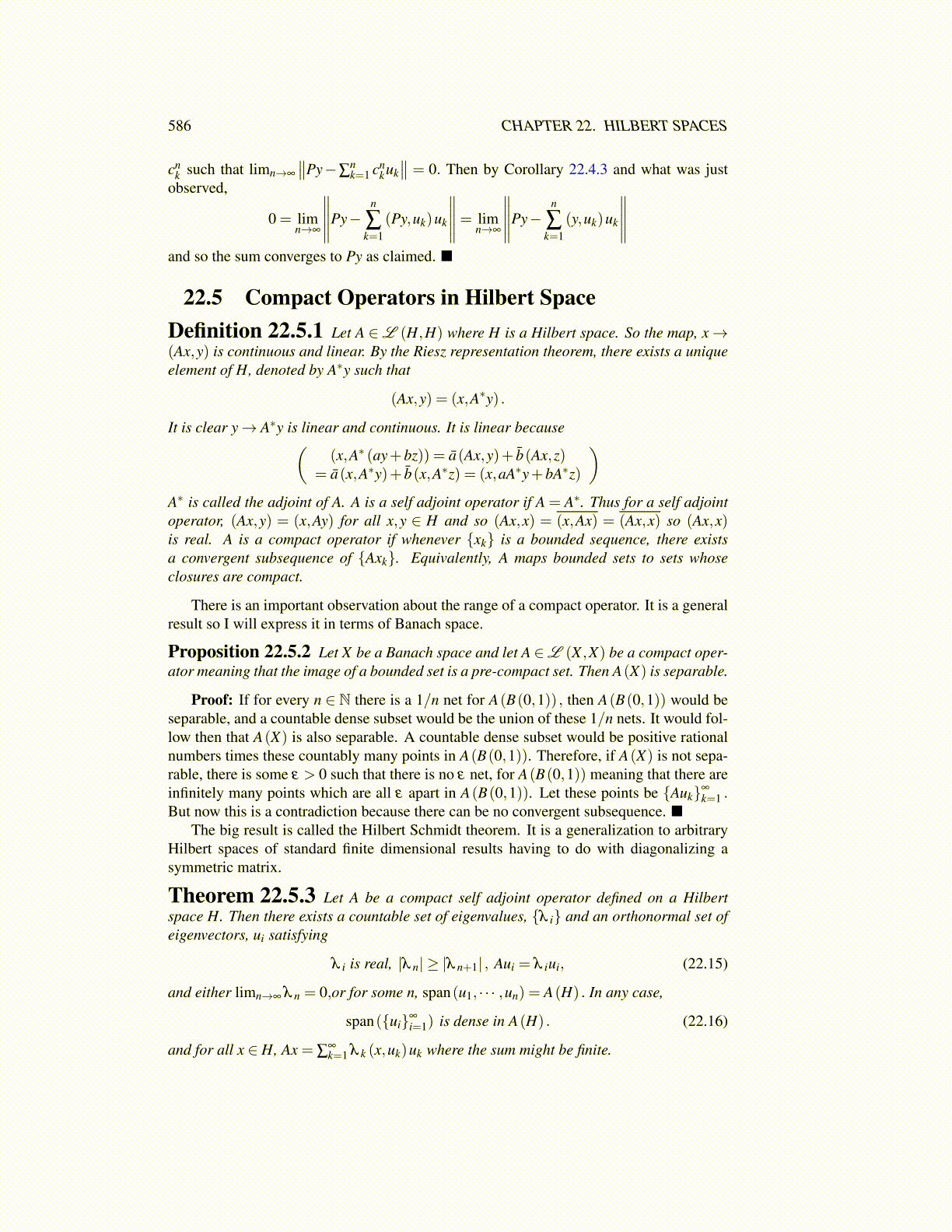
586 CHAPTER 22. HILBERT SPACES
cnk such that limn→∞
∥∥Py−∑nk=1 cn
kuk∥∥ = 0. Then by Corollary 22.4.3 and what was just
observed,
0 = limn→∞
∥∥∥∥∥Py−n
∑k=1
(Py,uk)uk
∥∥∥∥∥= limn→∞
∥∥∥∥∥Py−n
∑k=1
(y,uk)uk
∥∥∥∥∥and so the sum converges to Py as claimed. ■
22.5 Compact Operators in Hilbert SpaceDefinition 22.5.1 Let A ∈L (H,H) where H is a Hilbert space. So the map, x→(Ax,y) is continuous and linear. By the Riesz representation theorem, there exists a uniqueelement of H, denoted by A∗y such that
(Ax,y) = (x,A∗y) .
It is clear y→ A∗y is linear and continuous. It is linear because((x,A∗ (ay+bz)) = ā(Ax,y)+ b̄(Ax,z)
= ā(x,A∗y)+ b̄(x,A∗z) = (x,aA∗y+bA∗z)
)A∗ is called the adjoint of A. A is a self adjoint operator if A = A∗. Thus for a self adjointoperator, (Ax,y) = (x,Ay) for all x,y ∈ H and so (Ax,x) = (x,Ax) = (Ax,x) so (Ax,x)is real. A is a compact operator if whenever {xk} is a bounded sequence, there existsa convergent subsequence of {Axk}. Equivalently, A maps bounded sets to sets whoseclosures are compact.
There is an important observation about the range of a compact operator. It is a generalresult so I will express it in terms of Banach space.
Proposition 22.5.2 Let X be a Banach space and let A ∈L (X ,X) be a compact oper-ator meaning that the image of a bounded set is a pre-compact set. Then A(X) is separable.
Proof: If for every n ∈ N there is a 1/n net for A(B(0,1)) , then A(B(0,1)) would beseparable, and a countable dense subset would be the union of these 1/n nets. It would fol-low then that A(X) is also separable. A countable dense subset would be positive rationalnumbers times these countably many points in A(B(0,1)). Therefore, if A(X) is not sepa-rable, there is some ε > 0 such that there is no ε net, for A(B(0,1)) meaning that there areinfinitely many points which are all ε apart in A(B(0,1)). Let these points be {Auk}∞
k=1 .But now this is a contradiction because there can be no convergent subsequence. ■
The big result is called the Hilbert Schmidt theorem. It is a generalization to arbitraryHilbert spaces of standard finite dimensional results having to do with diagonalizing asymmetric matrix.
Theorem 22.5.3 Let A be a compact self adjoint operator defined on a Hilbertspace H. Then there exists a countable set of eigenvalues, {λ i} and an orthonormal set ofeigenvectors, ui satisfying
λ i is real, |λ n| ≥ |λ n+1| , Aui = λ iui, (22.15)
and either limn→∞ λ n = 0,or for some n, span(u1, · · · ,un) = A(H) . In any case,
span({ui}∞
i=1) is dense in A(H) . (22.16)
and for all x ∈ H, Ax = ∑∞k=1 λ k (x,uk)uk where the sum might be finite.